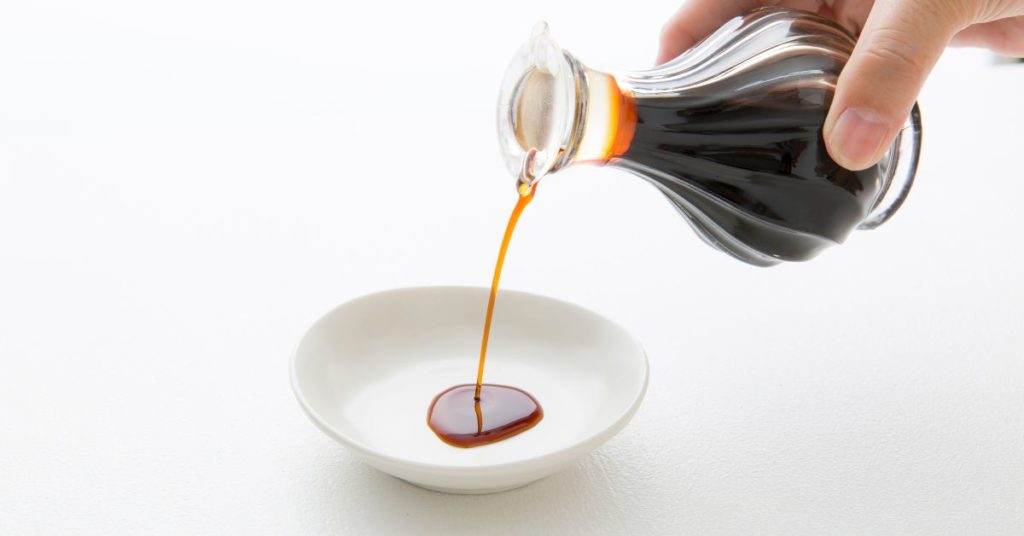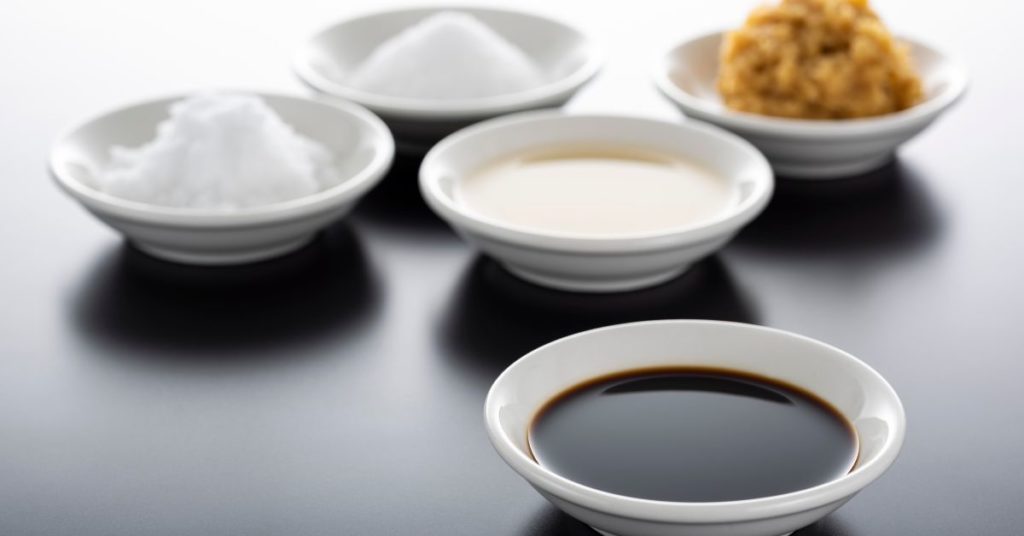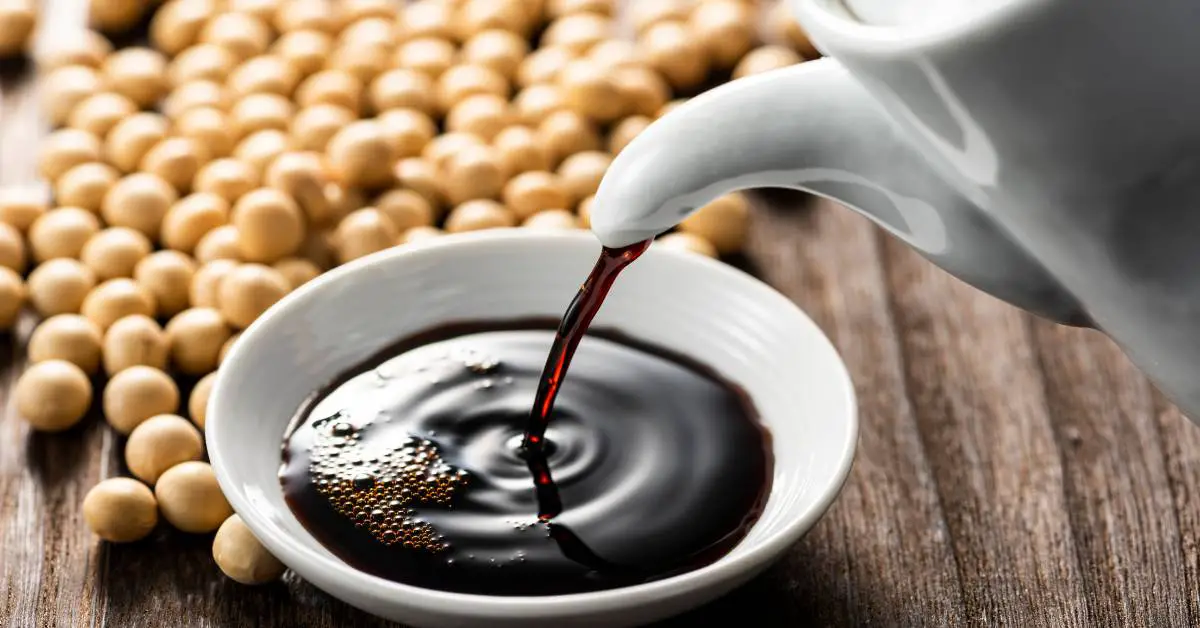Is soy sauce high histamine? As you know, what you eat can affect the histamine level in your body, and if you can’t break it down quickly enough, it builds up and triggers histamine intolerance symptoms.(6)
Therefore, if you have histamine intolerance, you’ll want to steer away from foods that contain histamine or a lot of other biogenic amines.
Plus, it’s also a good idea to avoid foods that trigger mast cells to release histamine, known as histamine liberators. Some common histamine liberators include alcohol, dairy products, fermented foods, and citrus fruits.
With the increasing interest in histamine intolerance, many people wonder whether soy sauce is a high-histamine food. Let’s take a closer look.
What Is Soy Sauce Made Of?
Is soy sauce high histamine? To understand whether soy sauce is safe to eat if you have histamine intolerance, you must know the ingredients and how soy sauce makers make their flavorful condiment. It’s made from fermented soybeans, wheat, salt, and water. (2)
If you have histamine intolerance, the word “fermented” raises eyebrows because fermented foods are high in histamine. (4) Fermented foods such as kimchi, sauerkraut, kefir, and yogurt are all high in histamine and may contain other biogenic amines, such as tyramine and putrescine, that can trigger symptoms for some people with histamine intolerance.
Where does histamine come from? During the fermentation process of any food, and it accumulates as the food ages. For those with histamine intolerance, consuming fermented foods and other foods that contain histamine can lead to histamine overload and trigger symptoms.
That’s why eating leftovers isn’t a smart idea. Bacteria that accumulate in leftovers may produce histamine as the food ages.
Since soy sauce undergoes fermentation, it can also trigger histamine intolerance symptoms.

Soy Sauce Is Fermented
Be wary of eating in Chinese restaurants if you have histamine intolerance. In one study, researchers measured the histamine content of 31 common Chinese dishes, 12 condiments, and 12 basic ingredients from various sources using a sensitive and specific radioenzymatic assay.
To ensure accuracy, a further enzymatic procedure involving diamine oxidase was used to verify that the substance measured was indeed histamine.(1)
The results were eye-opening. They found high levels of histamine in cheeses used as positive controls, as well as some common condiments, such as tamari (2392.2 micrograms histamine/g sample) and one brand of soy sauce (220.4 micrograms histamine/g sample).
The histamine content of four condiments and three common dishes exceeded 10 micrograms histamine/g sample, while four condiments and 16 common dishes contained less than 1 microgram histamine/g sample. (1)
Here’s where it gets scary. Calculations involving typical serving sizes of these dishes suggest histamine intake could approach toxic levels. These findings could help explain the symptoms of Chinese restaurant syndrome, which resemble those observed in scombroid poisoning, caused by ingesting spoiled fish with high levels of histamine.
If you enjoy Chinese or Japanese food, cook it at home using low-histamine foods and sauces.
Soy Sauce Contains Varying Amounts of Histamine
As you can see from the preceding study, soy sauce contains histamine, but tamari sauce contains even more. Tamari sauce is popular in Japanese food and used for dipping, marinating, or adding flavor to dishes. Tamari sauce is a dark and rich liquid made from fermented soybeans, salt, and water.
Unlike soy sauce, which often contains wheat, tamari sauce is typically made without wheat, making it gluten-free. This makes tamari sauce a suitable option for individuals with gluten sensitivity or celiac disease, but as the above research shows, tamari sauce is not a suitable substitute if you have histamine intolerance. .
Histamine levels in soy sauce and tamari sauce can vary depending on a few factors. One of the biggest factors is fermentation time.
Longer fermentation times lead to higher levels of histamine in soy sauce.
Another study found soy sauce contained high levels of histamine and two other biogenic amines, putrescine and spermidine. (3)
Storage conditions can also affect histamine levels.
When you store soy sauce at room temperature for long periods, histamine levels can increase.
In addition, the type of soy sauce can impact histamine levels. Despite the variability in histamine levels in soy sauce, studies suggest that it’s, in most cases, a high-histamine food.

Some people with histamine intolerance claim they can tolerate soy sauce without issues, but they may be using a brand that’s lower in histamine.
There seems to be lots of variability in the histamine content of commercial soy sauce. One brand may contain lower quantities of histamine because it was fermented and processed differently than another.
If you try soy sauce (despite it being a high-histamine food in many cases), keep this in mind. Choosing low-sodium or gluten-free options may be helpful if you have high blood pressure or gluten sensitivity.
However, most people with histamine intolerance find that limiting their intake of soy products, including soy sauce, is the safest approach.
When you buy commercial soy sauce, you don’t know what it’s histamine content is, as it’s not listed on the label. Finally, there are alternative condiments that people with histamine intolerance can use instead of soy sauce, such as rice vinegar or homemade dressings, and condiments made with low-histamine herbs and olive oil.
Is Soy Sauce High Histamine?
If you have histamine intolerance, soy sauce is one condiment to avoid. Instead, explore the world of lower histamine condiments that won’t increase your body’s histamine burden.
It’s best to make your own at home, but if you buy commercial sauces, read labels and understand the ingredients in your condiments to ensure they are safe to consume with histamine intolerance.
Be aware that commercial sauces and condiments may contain additional ingredients, such as preservatives or flavorings, that could potentially trigger histamine intolerance symptoms.
References:
1. Chin KW, Garriga MM, Metcalfe DD. The histamine content of oriental foods. Food Chem Toxicol. 1989 May;27(5):283-7. doi: 10.1016/0278-6915(89)90129-4. PMID: 2744659.
2. “How Is Soy Sauce Made and Is It Bad for You? – Healthline.” 07 Dec. 2017, https://www.healthline.com/nutrition/is-soy-sauce-bad-for-you.
3. (2023). Available at: https://www.tandfonline.com/doi/pdf/10.1271/bbb.61.1582 (Accessed: 27 April 2023).
4. Bodmer S, Imark C, Kneubühl M. Biogenic amines in foods: histamine and food processing. Inflamm Res. 1999 Jun;48(6):296-300. doi: 10.1007/s000110050463. PMID: 10442480.
5. San Mauro Martin I, Brachero S, Garicano Vilar E. Histamine intolerance and dietary management: A complete review. Allergol Immunopathol (Madr). 2016 Sep-Oct;44(5):475-83. doi: 10.1016/j.aller.2016.04.015. Epub 2016 Aug 31. PMID: 27590961.
6. Histamine, Histamine Degradation, and Histamine Intolerance (2023). Available at: https://www.clinicaleducation.org/resources/reviews/histamine-histamine-degradation-and-histamine-intolerance/ (Accessed: 27 April 2023).

